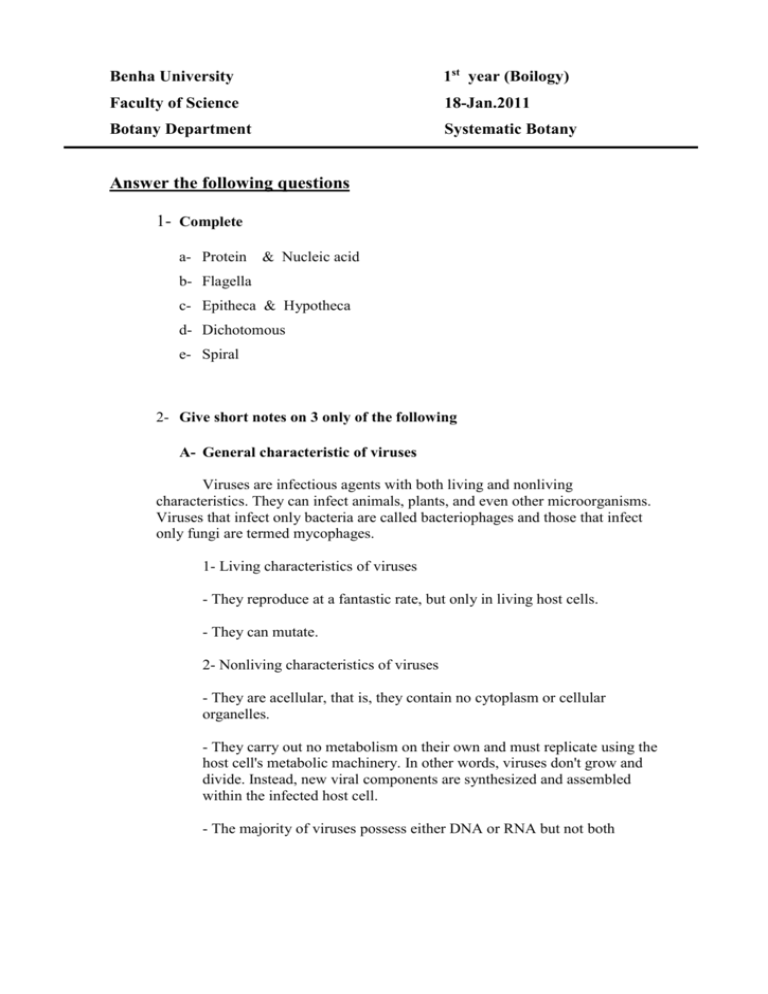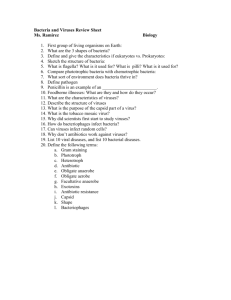Benha University 1st year (Boilogy) Faculty of Science 18
advertisement

Benha University 1st year (Boilogy) Faculty of Science 18-Jan.2011 Botany Department Systematic Botany Answer the following questions 1- Complete a- Protein & Nucleic acid b- Flagella c- Epitheca & Hypotheca d- Dichotomous e- Spiral 2- Give short notes on 3 only of the following A- General characteristic of viruses Viruses are infectious agents with both living and nonliving characteristics. They can infect animals, plants, and even other microorganisms. Viruses that infect only bacteria are called bacteriophages and those that infect only fungi are termed mycophages. 1- Living characteristics of viruses - They reproduce at a fantastic rate, but only in living host cells. - They can mutate. 2- Nonliving characteristics of viruses - They are acellular, that is, they contain no cytoplasm or cellular organelles. - They carry out no metabolism on their own and must replicate using the host cell's metabolic machinery. In other words, viruses don't grow and divide. Instead, new viral components are synthesized and assembled within the infected host cell. - The majority of viruses possess either DNA or RNA but not both B-Cyanophyta It is a blue green algae which differ from other algae in the following: - Lacking membrane bounded nuclei - Lacking mitochondria, Golgi apparatus and endoplasmic reticulum It is more connected with bacteria in the following: - With regard with reproduction - Prokaryotic organism - The wall of some species have constituent like bacteria They are unicellular, colonial form or filamentous. The most typical example is Nostoc. C-Diatoms - Most members are unicellular, having a yellow or golden brown color. - The cell wall composed of two overlapping halves. - In the side view we can detect either one of the valves, the outer (epitheca) and the inner (hypotheca). - They are penniless or central type - There are a rapha in the valve view. - Presence of silica in the cell wall. d- Morphology of bacteria Most bacterial species are either spherical, called cocci (sing. coccus, from Greek kókkos, grain, seed) or rod-shaped, called bacilli (sing. bacillus, from Latin baculus, stick). Elongation is associated with swimming. Some rod-shaped bacteria, called vibrio, are slightly curved or comma-shaped; others, can be spiral-shaped, called spirilla, or tightly coiled, called spirochaetes. A small number of species even have tetrahedral or cuboidal shapes. More recently, bacteria were discovered deep under the Earth's crust that grow as long rods with a star-shaped cross-section. The large surface area to volume ratio of this morphology may give these bacteria an advantage in nutrient-poor environments This wide variety of shapes is determined by the bacterial cell wall and cytoskeleton, and is important because it can influence the ability of bacteria to acquire nutrients, attach to surfaces, swim through liquids and escape predators. Many bacterial species exist simply as single cells, others associate in characteristic patterns: Neisseria form diploids (pairs), Streptococcus form chains, and Staphylococcus group together in "bunch of grapes" clusters. Bacteria can also be elongated to form filaments, for example the Actinobacteria. Filamentous bacteria are often surrounded by a sheath that contains many individual cells. Certain types, such as species of the genus Nocardia, even form complex, branched filaments, similar in appearance to fungal mycelia. 3- Draw 3 only life cycle of the following a- Chlamydomonas b- Spirogyra c- Fucus d- Rhizopus








